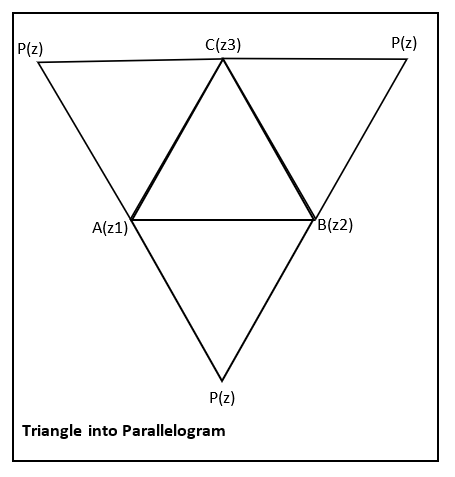
The complex numbers \[{{z}_{1}},{{z}_{2}},{{z}_{3}}\] are the vertices of a triangle. Then the complex numbers \[z\] which make the triangle into a parallelogram is
A. \[{{z}_{1}}+{{z}_{2}}-{{z}_{3}}\]
B. \[{{z}_{1}}-{{z}_{2}}+{{z}_{3}}\]
C. \[{{z}_{2}}+{{z}_{3}}-{{z}_{1}}\]
D. All of the above
Answer
218.4k+ views
Hint: In this question, we have to find the condition that makes the triangle into a parallelogram. For this, the complex vertices are used. Since we know that the opposite sides of a parallelogram are parallel and are equal in length, then we can frame the condition for the given triangle to form a parallelogram.
Formula Used: The complex number $(x,y)$ is represented by $x+iy$.
If $z=x+iy\in C$, then $x$ is called the real part and $y$ is called the imaginary part of $z$. These are represented by $\operatorname{Re}(z)$ and $\operatorname{Im}(z)$ respectively.
$z=x+iy$ be a complex number such that $\left| z \right|=r$ and $\theta $ be the amplitude of $z$. So, $\cos \theta =\dfrac{x}{r},\sin \theta =\dfrac{b}{r}$
And we can write the magnitude as
$\begin{align}
& \left| z \right|=\left| x+iy \right| \\
& \Rightarrow r=\sqrt{{{x}^{2}}+{{y}^{2}}} \\
\end{align}$
Thus, we can write
$z=x+iy=r\cos \theta +ir\sin \theta =r(\cos \theta +i\sin \theta )$
This is said to be the mod amplitude form or the polar form of $z$.
Where $\cos \theta +i\sin \theta $ is denoted by $cis\theta $ and the Euler’s formula is $\cos \theta +i\sin \theta ={{e}^{i\theta }}$
Complete step by step solution: Given that,
The vertices of a triangle are represented by the complex numbers \[{{z}_{1}},{{z}_{2}},{{z}_{3}}\].
So, consider those vertices as $A({{z}_{1}}),B({{z}_{2}}),C({{z}_{3}})$
Consider point $P$ that is represented by the complex number \[z\].
Then, we can construct three parallelograms from the triangle by adding the point $P$ as fourth vertices. Shown in the diagram below:

The three parallelograms we can construct are:
\[\begin{array}{*{35}{l}}
1)\text{ }A,B,P,C \\
2)B,P,C,A \\
3)C,A,P,B \\
\end{array}\]
In the first case, the vertices$A,B,P,C$ to form a parallelogram there must be $\overrightarrow{AB}=\overrightarrow{CP}$.
Then,
\[\begin{align}
& \overrightarrow{AB}=\overrightarrow{CP} \\
& \Rightarrow ({{z}_{2}}-{{z}_{1}})=(z-{{z}_{3}}) \\
& \Rightarrow z={{z}_{2}}+{{z}_{3}}-{{z}_{1}}\text{ }...(1) \\
\end{align}\]
In the second case, the vertices \[B,P,C,A\]to form a parallelogram there must be $\overrightarrow{BC}=\overrightarrow{AP}$.
Then,
\[\begin{align}
& \overrightarrow{BC}=\overrightarrow{AP} \\
& \Rightarrow ({{z}_{3}}-{{z}_{2}})=(z-{{z}_{1}}) \\
& \Rightarrow z={{z}_{1}}+{{z}_{3}}-{{z}_{2}}\text{ }...(2) \\
\end{align}\]
In the third case, the vertices \[C,A,P,B\]to form a parallelogram there must be $\overrightarrow{CA}=\overrightarrow{BP}$.
Then,
\[\begin{align}
& \overrightarrow{CA}=\overrightarrow{BP} \\
& \Rightarrow ({{z}_{1}}-{{z}_{3}})=(z-{{z}_{2}}) \\
& \Rightarrow z={{z}_{1}}+{{z}_{2}}-{{z}_{3}}\text{ }...(3) \\
\end{align}\]
Thus, all these three conditions lead the given triangle to form into a parallelogram.
Option ‘D’ is correct
Note: Here we need to remember the property of a parallelogram, that is the opposite vertices of a triangle are parallel to each other and are equal in their lengths.
Formula Used: The complex number $(x,y)$ is represented by $x+iy$.
If $z=x+iy\in C$, then $x$ is called the real part and $y$ is called the imaginary part of $z$. These are represented by $\operatorname{Re}(z)$ and $\operatorname{Im}(z)$ respectively.
$z=x+iy$ be a complex number such that $\left| z \right|=r$ and $\theta $ be the amplitude of $z$. So, $\cos \theta =\dfrac{x}{r},\sin \theta =\dfrac{b}{r}$
And we can write the magnitude as
$\begin{align}
& \left| z \right|=\left| x+iy \right| \\
& \Rightarrow r=\sqrt{{{x}^{2}}+{{y}^{2}}} \\
\end{align}$
Thus, we can write
$z=x+iy=r\cos \theta +ir\sin \theta =r(\cos \theta +i\sin \theta )$
This is said to be the mod amplitude form or the polar form of $z$.
Where $\cos \theta +i\sin \theta $ is denoted by $cis\theta $ and the Euler’s formula is $\cos \theta +i\sin \theta ={{e}^{i\theta }}$
Complete step by step solution: Given that,
The vertices of a triangle are represented by the complex numbers \[{{z}_{1}},{{z}_{2}},{{z}_{3}}\].
So, consider those vertices as $A({{z}_{1}}),B({{z}_{2}}),C({{z}_{3}})$
Consider point $P$ that is represented by the complex number \[z\].
Then, we can construct three parallelograms from the triangle by adding the point $P$ as fourth vertices. Shown in the diagram below:

The three parallelograms we can construct are:
\[\begin{array}{*{35}{l}}
1)\text{ }A,B,P,C \\
2)B,P,C,A \\
3)C,A,P,B \\
\end{array}\]
In the first case, the vertices$A,B,P,C$ to form a parallelogram there must be $\overrightarrow{AB}=\overrightarrow{CP}$.
Then,
\[\begin{align}
& \overrightarrow{AB}=\overrightarrow{CP} \\
& \Rightarrow ({{z}_{2}}-{{z}_{1}})=(z-{{z}_{3}}) \\
& \Rightarrow z={{z}_{2}}+{{z}_{3}}-{{z}_{1}}\text{ }...(1) \\
\end{align}\]
In the second case, the vertices \[B,P,C,A\]to form a parallelogram there must be $\overrightarrow{BC}=\overrightarrow{AP}$.
Then,
\[\begin{align}
& \overrightarrow{BC}=\overrightarrow{AP} \\
& \Rightarrow ({{z}_{3}}-{{z}_{2}})=(z-{{z}_{1}}) \\
& \Rightarrow z={{z}_{1}}+{{z}_{3}}-{{z}_{2}}\text{ }...(2) \\
\end{align}\]
In the third case, the vertices \[C,A,P,B\]to form a parallelogram there must be $\overrightarrow{CA}=\overrightarrow{BP}$.
Then,
\[\begin{align}
& \overrightarrow{CA}=\overrightarrow{BP} \\
& \Rightarrow ({{z}_{1}}-{{z}_{3}})=(z-{{z}_{2}}) \\
& \Rightarrow z={{z}_{1}}+{{z}_{2}}-{{z}_{3}}\text{ }...(3) \\
\end{align}\]
Thus, all these three conditions lead the given triangle to form into a parallelogram.
Option ‘D’ is correct
Note: Here we need to remember the property of a parallelogram, that is the opposite vertices of a triangle are parallel to each other and are equal in their lengths.
Recently Updated Pages
Chemical Properties of Hydrogen - Important Concepts for JEE Exam Preparation

JEE General Topics in Chemistry Important Concepts and Tips

JEE Atomic Structure and Chemical Bonding important Concepts and Tips

JEE Amino Acids and Peptides Important Concepts and Tips for Exam Preparation

JEE Extractive Metallurgy Important Concepts and Tips for Exam Preparation

Algebra Made Easy: Step-by-Step Guide for Students

Trending doubts
JEE Main 2026: Application Form Open, Exam Dates, Syllabus, Eligibility & Question Papers

Derivation of Equation of Trajectory Explained for Students

Hybridisation in Chemistry – Concept, Types & Applications

Understanding the Angle of Deviation in a Prism

Understanding Collisions: Types and Examples for Students

Understanding Atomic Structure for Beginners

Other Pages
JEE Advanced Marks vs Ranks 2025: Understanding Category-wise Qualifying Marks and Previous Year Cut-offs

NCERT Solutions for Class 11 Maths Chapter 10 Conic Sections

NCERT Solutions for Class 11 Maths Chapter 9 Straight Lines

NCERT Solutions For Class 11 Maths Chapter 8 Sequences And Series

How to Convert a Galvanometer into an Ammeter or Voltmeter

NCERT Solutions For Class 11 Maths Chapter 12 Limits And Derivatives




